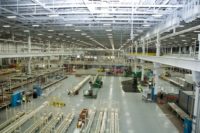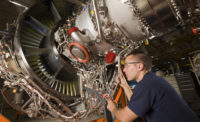This article is a Special Report on the State of the Profession 2012
That a difference a few years make. Back in 2009, it was all doom and gloom for American manufacturers. But, today, all signs indicate that the United States is in the early stages of a manufacturing renaissance.
Reshoring activity has steadily increased in recent months as manufacturers shift production from China, Mexico and other traditionally low-wage countries. Both large and small companies in a wide variety of industries have added, or are planning to add, U.S. production after assessing the total costs and risks involved in offshoring.
For instance, ET Water Systems LLC, a maker of irrigation controls, recently relocated its assembly line from Dalian, China, to San Jose, CA, to improve quality and yield. AmFor Electronics Inc., an electronics manufacturing services company, cites delivery responsiveness, ease of design revisions and implementation of lean manufacturing practices as reasons for reshoring wire harness production from China and Mexico to Portland, OR.
Other manufacturers, including General Electric, Master Lock, NCR and Otis Elevator, have jumped on the reshoring bandwagon. Even some consumer electronics firms are getting in on the action.
|
When television manufacturing moved offshore 30 years ago, most observers never thought it would return. But, a start-up company called Element Electronics recently began mass-producing 46-inch and 50-inch flat-screen televisions at a factory in Canton, MI.
The 17th annual ASSEMBLY State of the Profession survey captured some of the recent uptick in reshoring activity. For instance, 19 percent of respondents claim that their company has brought jobs back to the states from overseas. And, 16 percent expect their companies to reshore assembly operations during the next 12 months.
A recent study conducted by the Boston Consulting Group Inc. (BCG) confirms this trend. According to BCG, more than a third of U.S.-based manufacturing executives at companies with sales greater than $1 billion are planning to bring back production to the United States from China or are considering it.
The top factors cited as driving future decisions on production locations are labor costs (57 percent), product quality (41 percent), ease of doing business (29 percent) and proximity to customers (28 percent). In addition, 92 percent of respondents believe that labor costs in China “will continue to escalate,” and 70 percent claim that “sourcing in China is more costly than it looks on paper.”
The return of U.S. manufacturing may be one reason why assembly professionals are the happiest they’ve been since ASSEMBLY started tracking that attribute in the mid-1990s. Almost one-half (49 percent) of respondents say they are “highly satisfied” with their jobs today. That’s 7 percentage points higher than in 2011 and 14 percentage points higher than in 2010.
The 2012 State of the Profession survey was conducted in March, as the manufacturing sector continued to pace the U.S. economy. According to the Federal Reserve Bank, industrial production grew at more than a 10 percent annual rate in the first quarter of 2012.
“Machinery and equipment demand is driving growth in the manufacturing sector,” says Daniel Meckstroth, chief economist at the Manufacturers Alliance/MAPI. “The prolonged recession caused firms to postpone investment and reduce capacity. Now that economic growth has continued for more than two-and-a-half years, the need for machinery and equipment replacementhas built up to the point where the pent-up demand is being released.”
While the housing market remains shaky, the U.S. auto industry is driving the manufacturing sector. Many assembly plants are operating 24 hours a day for the first time in more than three years. The automotive industry expects to run at 81 percent capacity in 2012 vs. 49 percent in 2009. To meet pent-up demand, Chrysler, Ford and General Motors have added third shifts at some assembly plants and cancelled or curtailed traditional summer shutdowns.
The average age of cars that consumers are trading in today is six years old, which is the oldest since 2007. Auto sales are expected to run above 14.4 million vehicles this year, which is a 12.5 percent increase over 2011 and a 26 percent increase over the dark days of 2009.
Talent Shortage
As the manufacturing sector continues its dramatic turnaround, there’s a growing demand for talent. More than half (53 percent) of respondents claim that the number of people employed at their plant has increased during the past year. That’s 16 percentage points higher than 2011 and a whopping 40 percentage points higher than 2009.
Assemblers in the fabricated metal products industry report the biggest demand (63 percent), followed by the electrical equipment and appliance industry (63 percent). The computer and electronic products industry (25 percent) has hired the fewest number of assemblers in the past 12 months.
The fabricated metal products industry, which includes manufacturers of ammunition, doors, firearms, hand tools, hinges, springs, valves and windows, expects to commit the most resources toward improving assembly operations during the next 12 months. Indeed, 60 percent of assemblers in that category will be investing in their plants, followed by contract manufacturers (59 percent), electrical equipment and appliance manufacturers (53 percent), machinery manufacturers (51 percent) and transportation equipment manufacturers (50 percent).
Manufacturers in the computer and electronics industry (28 percent) are the least likely to commit resources to their assembly operations during the next 12 months.
As manufacturers ramp up their lines, the transportation sector (63 percent) expects to have the hardest time finding qualified assemblers. On the other hand, only 30 percent of assemblers in the electrical equipment and appliance industry predict they’ll experience a staffing shortage.
Mid-sized manufacturers (companies with 250 to 500 employees) have hired the most assemblers in the past year (62 percent), followed by large manufacturers (companies with 1,000 employees or more) at 54 percent and small manufacturers (companies with less than 50 employees) at 44 percent.
Large manufacturers (67 percent) also expect to have the hardest time finding skilled workers in the near future, followed by mid-sized manufacturers (56 percent) and small manufacturers (39 percent).
| Top Factors driving future decisions on production locations |
|
labor costs (57 percent) |
| product quality (41 percent) |
| ease of doing business (29 percent) |
| proximity to customers (28 percent) |
The Manufacturing Institute claims that 82 percent of American manufacturers are experiencing moderate to severe shortages of qualified workers. And, 69 percent of manufacturers expect the shortage to worsen in the next three to five years.
“While manufacturing is leading the economic recovery in the United States, it’s been complicated because fewer workers are qualified to replace retiring baby boomers, who are retiring with vast amounts of knowledge and experience,” says Paul Borawski, CEO of the American Society for Quality. His organization recently joined forces with the Manufacturing Institute to address the issue and train the next generation of skilled workers.
According to a recent study conducted by the Society for Human Resource Management, two-thirds of manufacturers report finding skilled workers for specific openings. The positions most difficult to fill were high-skilled technicians (89 percent) and engineers (88 percent).
The top skills gaps in manufacturing were critical thinking and problem solving (59 percent), teamwork (45 percent), leadership (42 percent) and written communication (39 percent). Manufacturers are experiencing the following knowledge gaps among job applicants: mathematics (60 percent), writing in English (40 percent) and reading comprehension (40 percent).
Compensation Holds Steady
The typical State of the Profession survey respondent is 52 years old, has 25 years of experience and earns $87,383. However, there are exceptions at both the high and low ends of the scale. For instance, 20 percent of respondents take home less than $60,000 per year, while 33 percent earn more than $90,000.
Assemblers are feeling the effects of the rapidly improving economy. More than half (56 percent) of respondents received a pay increase over the last 12 months. Only 8 percent experienced a decrease in salary. The typical raise ranged from 3 percent to 5 percent.
Almost half (47 percent) of ASSEMBLY’s respondents received a cash bonus during the last 12 months. Extra compensation was typically based on overall company and plant performance, in addition to implementing cost reduction programs, launching new products and meeting deadlines for new projects.
Fifty-seven percent of assemblers who work for companies that manufacture cars, trucks, aircraft, locomotives and other transportation equipment received a cash bonus during the past year. By comparison, only 39 percent of assemblers who work in the in the machinery manufacturing industry received bonuses.
Fifty-five percent of State of the Profession respondents expect to receive a salary increase at their next review. Assemblers in the plastics and rubber products industry, which includes manufacturers of hoses, pipes, fittings and plumbing fixtures, feel most confident about receiving an increase in the near future. Indeed, 81 percent of those individuals say they expect a raise.
But, assembly professionals in the computer and electronic products industry, which includes manufacturers of antennas, audiovisual equipment, laboratory instruments, loudspeakers and process control instruments, are less optimistic. Only 46 percent expect a raise during the next 12 months.
Assemblers who work for larger manufacturers (1,000 or more employees) are more likely to receive a bonus than those employed by companies with less than 100 employees.
Several factors determine compensation, such as age, education, location and industry. Industry experience is the biggest factor that determines pay rates. Individuals with less than 10 years of experience in the assembly field (11 percent of respondents) earn less than industry veterans with more than 15 years of experience (83 percent of respondents).
Assembly professionals tend to be loyal employees who stay with the same company for long periods of time. In fact, 51 percent of respondents have worked at the same firm for more than 10 years, while 13 percent have been with their present employer for less than two years.
While that trend has held steady the past few years, the pendulum may soon begin swinging the other way. According to a recent study conducted by MetLife Inc., employee loyalty is at a seven-year low. One-third of employees in all industries plan to leave their job by the end of this year.












